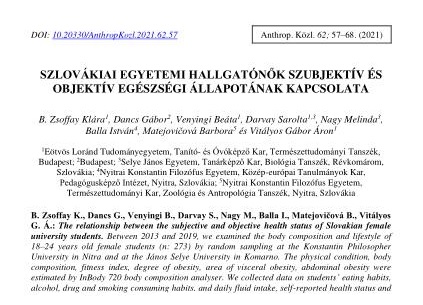Szlovákiai egyetemi hallgatónők szubjektív és objektív egészségi állapotának kapcsolata
Absztrakt
Between 2013 and 2019, we examined the body composition and lifestyle of 18–24 years old female students (n: 273) by random sampling at the Konstantin Philosopher University in Nitra and at the János Selye University in Komarno. The physical condition, body composition, fitness index, degree of obesity, area of visceral obesity, abdominal obesity were estimated by InBody 720 body composition analyser. We collected data on students’ eating habits, alcohol, drug and smoking consuming habits, and daily fluid intake, self-reported health status and physical self-concept by using questionnaires.
Based on the body mass index, 72% of the examined students had normal nutritional status, 4% were undernourished, 12% were overweight and 5% were obese. It is an interesting data that students’ subjective perceptions of their own nutritional status differed from the measured values, as 44% of them considered themselves overweight or obese. One-third of people having normal nutritional status considered themselves overweight or obese, 70% of those who were actually overweight considered themselves overweight, nearly 30% considered obese and half of those who were truly abnormally obese considered themselves only slightly overweight, and the other half estimated their nutritional status realistically. 22% of students admitted to dieting mainly (81%) to reduce their weight. 65% of dieters had normal nutritional status, 32% are overweight or obese and 3% were undernourished. In terms of body fat percentage, 42% of examined participants were in the normal category, 42% were overweight, 12% were obese and 5% were too lean. In terms of visceral fat 72% of students were in the normal category, 13% were in high and 14% were in critical category for health risk. The distribution of students’ fitness index indicated that their physical activity was insufficient, 46% of them did not reach the average (normal) fitness value. The research results revealed that one-third of students should move toward a healthier, more conscious, more active lifestyle.
Hivatkozások
Bennett, J.E., Stevens, G.A., Mathers, C.D., Jürgen Rehm, R.B., Kruk, M.E., Riley, L.M., Kengne, A.P., Chalkidou, K., Beagley, J., Kishore, S., Chen, W., Saxena, S., Douglas, W., Bettcher, Grove, J., Beaglehole, R., Ezzati, M. (2018): NCD Countdown 2030: worldwide trends in non-communicable disease mortality and progress towards Sustainable Development Goal target. Lancet, 392(10152): 1072–1088. DOI: https://doi.org/10.1016/S0140-6736(18)31992-5
Danková, Z., Cvíčelová, M., Siváková, D. (2013): Telesné zloženie a indexy obezity u slovenských študentov vo veku od 16 do 25 rokov (The body composition and obesity indices in Slovak students aged from 16 to 25 years). Česká Antropologie, 63(1): 9–14.
Dubé, L., Bechara, A., Dagher, A., Dewnowski, A., Lebel, J., James, P., Yada, R.Y. (Ed. 2010): Obesity Prevention. A Role of Brain and Society on Individual Behavior. Academic Press, London, UK.
Dudley, D.A., Cotton, W.G., Peralta, L.R. (2015): Teaching approaches and strategies that promote healthy eating in primary school children: a systematic review and meta-analysis. International Journal of Behavioral Nutrition and Physical Activity, 12(1): 1–26. DOI: https://doi.org/10.1186/s12966-015-0182-8
Dukát, A., Lietava, J., Krahulec, B., Čaprnda, M., Vacula, I., Sirotiaková, J., Minárik, P. (2007): Prevalencia abdominálnej obezity na Slovensku, štúdia IDEA Slovakia (The prevalence of abdominal obesity in Slovakia. The IDEA Slovakia study). Vnitřní lékařství, 53: 326–330.
Európai Unió (2021) European Health Interview Survey (EHIS). http://ec.europa.eu/eurostat/web/microdata/european-health-interview-survey
Hajtman, B. (1971): Bevezetés a matematikai statisztikába pszichológusok számára. Akadémiai Kiadó. Budapest.
Kalvach, Z., Zadák, Z., Jirák, R., Zavázalová, H., Sucharda, P. (2004): Geriatrie a gerontologie (Geriatrics and gerontology). Grada, Praha, Csehország.
Központi Statisztikai Hivatal (2019): Európai Lakossági Egészségfelmérés. https://www.ksh.hu/elef
Marsman, D., Belsky, D.W., Gregori, D., Johnson, M.A., Low Dog, T., Meydani, S., Pigat, S., Sadana, R., Shao, A., Griffiths, J.C. (2018): Healthy ageing: the natural consequences of good nutrition - a conference report. European Journal of Nutrition. 57(2): 15–34. DOI: https://doi.org/10.1007/s00394-018-1723-0
Moreno, L.A., Gottard, F., Huybrechts, I., Ruiz, J.R., González Gross, M., DeHenauw, S. (2014): Nutrition and lifestyle in European adolescents: the HELENA study. Advances in Nutrition, 5(5): 615S-623S. DOI: https://doi.org/10.3945/an.113.005678
Ruthsatz, M., Candeias, V. (2020): Non-communicable disease prevention, nutrition and aging. Acta bio-medica: Atenei Parmensis, 91(2): 379–388. DOI: https://doi.org/10.23750/abm.v91i2.9721
Sofková, T., Přidalová, M. (2015): Somatic characteristics in relation to meeting recommended physical activity in overweight and obese women aged 30–60 years. Acta Gymnica, 45(3): 121–128. DOI: https://doi.org/10.5507/ag.2015.013
Sofková, T., Přidalová, M., Pelclová, J. (2014): The effect of movement intervention for women attending courses in weight reduction. Acta Gymnica, 44: 47–56.
Weiner, J.S., Lourie, J.A. (1969): Human Biology, A Guide to Field Methods. IBP.
Whitt, M.C., Kumanyika, S., Bellamy, S. (2003): Amount and bouts of physical activity in a sample of African-American women. Medicine & Science in Sports & Exercise, 35:
–1893. DOI: https://doi.org/10.1249/01.MSS.0000093618.60631.C3
Williams, C., Ashwell, M., Prentice, A., Hickson, M., Stanner, S. (2020): Nature of the evidence base and frameworks underpinning dietary recommendations for prevention of non-communicable diseases: A position paper from the Academy of Nutrition Sciences. British Journal of Nutrition, 126(7): 1076–1090. DOI: https://doi.org/10.1017/S0007114520005000
World Health Organization (1995): Physical Status: The use and interpretation of anthropometry: Report of a WHO Expert Committee. Technical Report Series 854, WHO, Geneva. http://apps.who.int/iris/bitstream/10665/37003/1/WHO_TRS_854.pdf
World Health Organization (2014): European food and nutrition action plan 2015–2020. WHO, Geneva. https://euro.who.int/__data/assets/pdf_file/0008/253727/64wd14e_FoodNutAP_140426.pdf
World Health Organization (2016): Action plan for the prevention and control of non-communicable diseases in the WHO European Region. WHO, Geneva. https://euro.who.int/__data/assets/pdf_file/0008/346328/NCD-ActionPlan-GB.pdf




